



The Malwa region of Punjab houses several ‘high-burn’ districts and has the highest number of post-Kharif farm fires in the state. Currently, it accounts for over 80 per cent of the 40,000+ farm fires detected so far this year using satellite imagery in Punjab1.
Our last blog featured stories of stubble burning from Punjab’s Majha region. Field visits to the area presented challenges such as high operational costs of crop residue management (CRM) machines as well as small-scale solutions to the problem.
Recognising the importance of the Malwa region for paddy residue burning, we spent the second fortnight of October visiting Sangrur, Ludhiana, Patiala, and Faridkot, which have witnessed a recent uptick in fire counts. We interacted with farmers, agri-entrepreneurs, the state agriculture department, and Krish Vigyaan Kendras (KVKs) to understand what keeps Malwa’s farms on fire.
In addition to the cost implications discovered in Majha, findings in Malwa include the dependence on the PUSA 44 variety of paddy, a preference for ex-situ2 CRM, and high supply chain costs.
Persistent use of high-yield paddy, lack of government support for crop diversification, and unseasonal rains have contributed to farm fires.
Higher fire counts in this region can be attributed to farmers’ preference for the long-duration PUSA 44 paddy variety. PUSA 44 is a high-yielding rice variety that matures in about 160 days after sowing, which leaves less time for CRM, and has a high straw load, which increases crop residue. Despite the state government and the Punjab Agricultural University’s attempt to discourage its use due to its long-duration and input-intensive production, farmers continue to prefer this rice variety owing to its higher yield compared to short-duration alternatives. During Kharif 2020, over 27 per cent3 of the area across the Malwa districts was under PUSA 44 (Figure 1).
When asked if there’s been any shift in recent years, agriculture officers in Ludhiana said that the crop mix has not changed since 2020. “While the area under PR 126, PR 121, and PR 122 (early maturing varieties) has increased, PUSA 44 remains the first choice for a sizable number of farmers. According to our estimates, 38 per cent of the area under paddy in Ludhiana is of the PUSA 44 variety,” said an officer.
The time crunch for crop residue management arising due to the high prevalence of the PUSA 44 variety in the region was also compounded4 by the late retreat of the southwest monsoon and unseasonal rains in the first week of October 2022.
Apart from the diversity in seed varieties of paddy, the state has also accepted the need for crop diversification. The state government’s announcement of procurement was meant to act as a fillip to crop diversification. However, views on the procurement of moong in Malwa and its implications for crop diversification were identical to our observations in Majha. Agriculture officers highlighted that the lacklustre procurement of moong will dent future prospects of diversification. One officer pointed out: “Moong was not procured at scale as it did not meet procurement parameters. The parameters should have been relaxed as farmers are not acquainted with cultivation practices. In any case, the INR 1,000 deficiency payment5 was not enough6 as farmers sold their produce for as low as INR 4,500/quintal compared to the MSP of INR 7,755/quintal.”
The number of in-situ crop residue management machines in Punjab has surged. In-situ refers to the management of crop residue within the farm. This is done via surface decomposition or incorporation into the soil. In-situ CRM is facilitated by machines such as mulchers and Super Seeders as well as microbial decomposers.
The prevalence of PUSA 44 and the delayed harvest are both potent barriers to no-burn CRM. However, in-situ7 CRM machines such as Happy and Super Seeders should theoretically have enabled farmers to shun residue burning. Backed by the central government’s subsidy scheme, the stock of in-situ CRM machines has swelled in the region. Between 2018 and 2020, farmers (individuals and groups) in Sangrur8, Ludhiana, Patiala, and Faridkot procured over 6,300, 4,850, 4,000, and 3,850 such machines respectively.
However, the effective utilisation of these machines is hindered by a lack of technical know-how, underutilisation of older machines, and most importantly, the additional expenditure required for no-burn CRM.
The state government did propose10 an incentive of INR 2,500 per acre to cover the additional expenditure, but the plan did not materialise. In the absence of monetary support for the operational expenditure of in-situ machines, the agriculture department is betting big on its Information, Education & Communication (IEC) activities. Agriculture officers in Ludhiana highlighted the department’s 168 CRM training camps and deployment of 10 vans to cover 600 villages informing farmers of no-burn technologies.
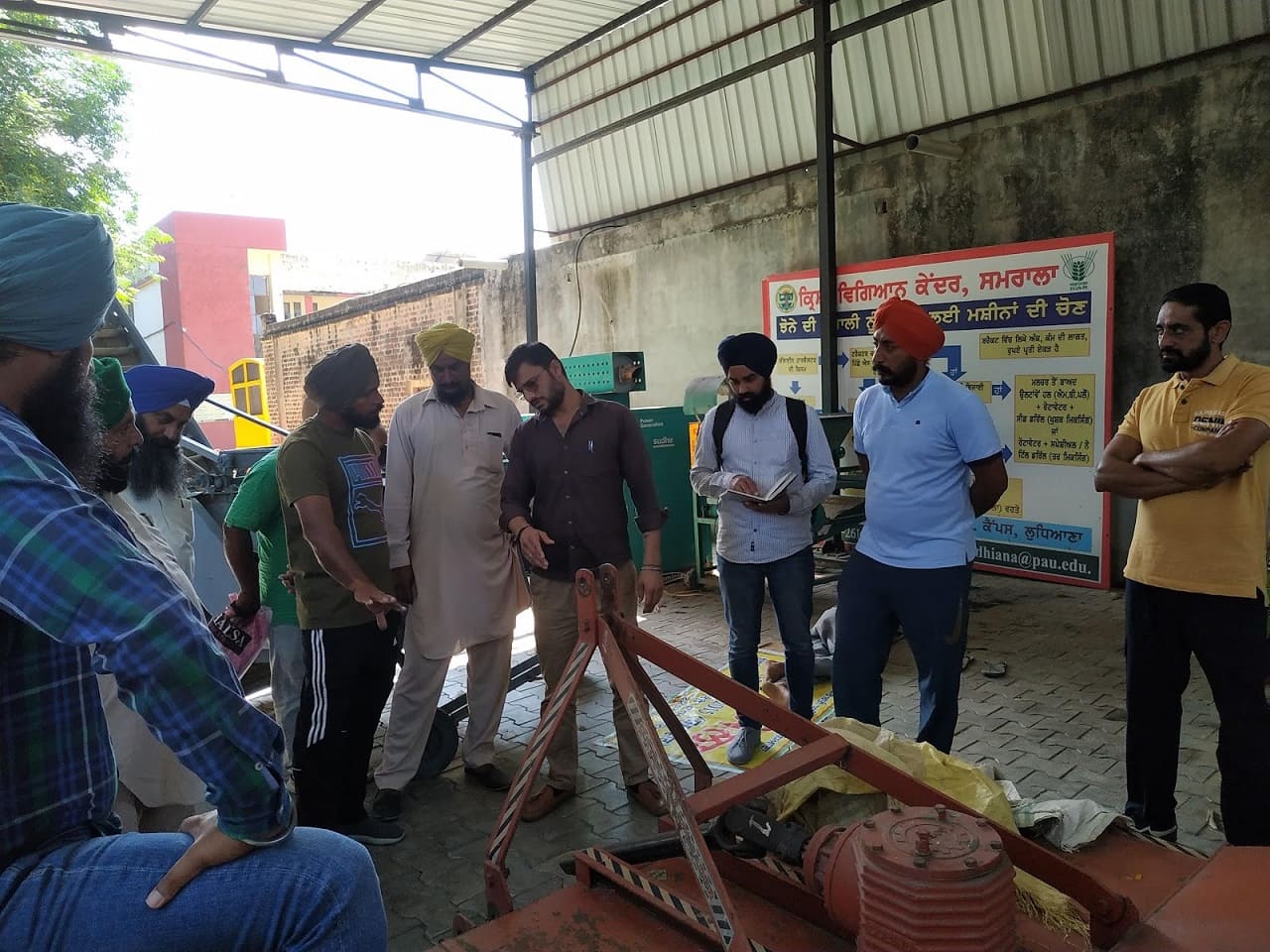
CEEW’s Ramandeep Singh at a training session on CRM organised by KVK Samrala (Ludhiana) Source: CEEW
A peculiar yet frequent observation in Malwa was farmers using Super Seeders after burning residue. The Super Seeder is a tractor-towed CRM machine that incorporates paddy residue into the ground while sowing wheat.
“Farmers are using the super seeder after partially burning11the stubble. This is common but not the norm. We cannot do much if farmers do not put our advice into practice,” an agricultural officer said. Although anecdotal, this shows that despite the scale of IEC activities, farmers' lack of technical know-how on in-situ CRM machines points to the need for reinvigorating agricultural extension education12.
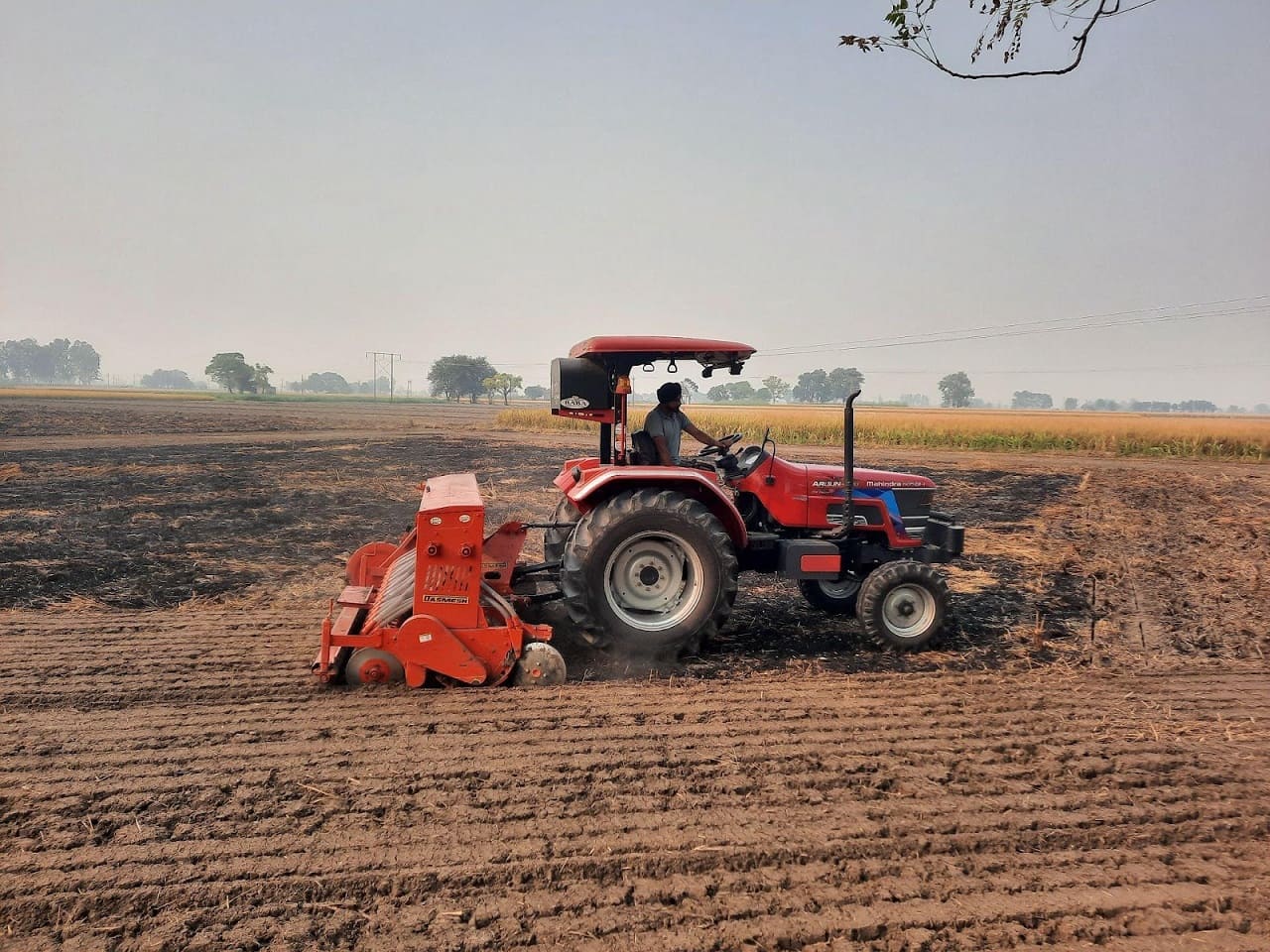
A farmer from Sangrur uses his Super Seeder after burning the paddy residue on his field. Source: CEEW
A positive takeaway from Malwa is the role of cooperative societies in providing rental CRM machines at affordable rates. For instance, the Hambran Co-op Society charges INR 650 per acre13 for each of their six Super Seeders (along with a tractor) with the farmer bearing the fuel cost.
As highlighted in CEEW’s October 2021 issue brief, farmer interactions revealed that the Super Seeder remains the most preferred in-situ machine. However, an average capital expenditure of INR 2,70,000 per unit deters farmers from buying the machine despite the existence of subsidies. The custom hiring centre (CHC) model was devised to bypass this expenditure by introducing rental services. However, rental rates of super seeders offered by individual farmers and farmer groups range between INR 2,000 to INR 3,000 per acre against government-recommended rates of INR 1,600 to INR 200014. The high operational expenditure of these machines prevents farmers from accessing the CHC model.
CEEW’s research has previously found ex-situ CRM to be highly acceptable among farmers. The sector is now expanding in the Malwa region.
The sight of tractors ferrying bales of paddy stubble was a big positive during our field visits. The Malwa region accounts for 8 of Punjab’s 11 biomass power projects (97.5 MW) that consume 0.88 million tonnes of stubble annually. The operationalisation of Asia’s largest compressed biogas (CBG)15 plant in Sangrur further augments the state’s ex-situ stubble use.
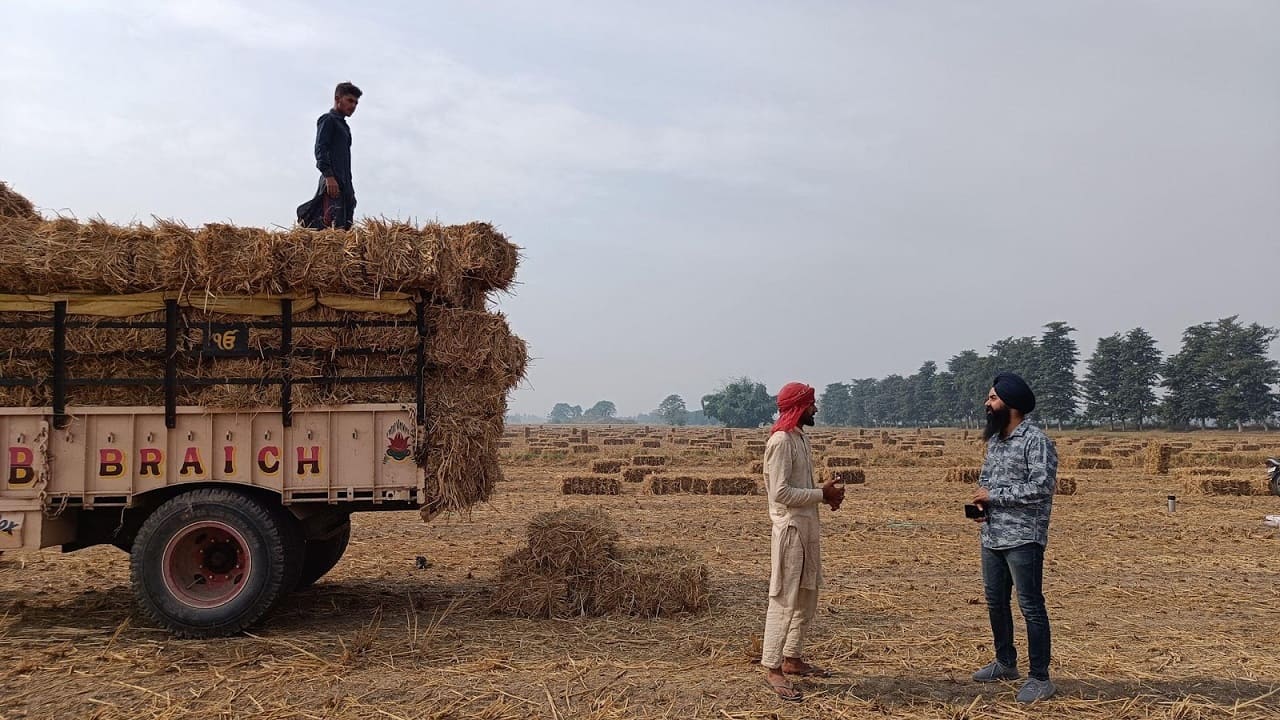
CEEW’s Ramandeep Singh interacting with a biomass aggregator in Ludhiana Source: CEEW
Farmers prefer ex-situ CRM for two reasons. First, unlike in-situ CRM, it does not alter their land.
“I will not use the super seeder I own because using it reduced my wheat yield. With in-situ, there is a fear of weak roots, low germination, and pest infestation. Baling is the best CRM method,” Gurvinder Singh, a farmer in Ludhiana, explained.
Second, ex-situ CRM provides scope for additional income16. However, in addition to the business model where farmers are paid, we also encountered farmers who received no payment and farmers who paid the aggregator for baling.
Despite the lack of standardised procurement models, farmers remain committed to ex-situ CRM. Harinder Singh of Duareana village in Faridkot summed it up by saying, “I don’t get paid for the residue baled out from my fields. It would be better if we are paid. But I am happy as I don’t have to spend on in-situ CRM. The only improvement needed is that balers should not delay the collection process.”
Rising preference for ex-situ stubble use has led to the development of successful public-private-people partnerships. The agriculture department in Ludhiana has tied up with biomass aggregators to guarantee residue collection and created a cluster of ten no-burn villages relying on ex-situ CRM. The aggregator benefits from employing a business model where they do not pay for the residue. Scaling up such partnerships can lead to the creation of sustainable business models for ex-situ entrepreneurs.
While the increasing ex-situ end-use is encouraging, aggregators and end-users highlight barriers including high delivery cost and lack of storage, which were identified by CEEW in 2021. Aggregator Farm2Energy revealed the cost of biomass and baling machines, maintaining appropriate moisture levels (up to 20 per cent), costly storage, and the unregulated price of bales, are yet to be addressed. End-users like Shri Ganesh Edible Oils Pvt Ltd and Tiwana Oil Mills Pvt Ltd based in Fatehgarh Sahib also concurred with this.
This year the Minister of Environment, Forest, and Climate Change informed18 the Indian Parliament, of Punjab’s plan to manage 20.589 million tonnes of paddy residue by 2023-24. The plan envisions that 5.22 million tonnes of paddy residue will be managed through crop diversification, 10.70 million tonnes through in-situ CRM, and 4.669 million tonnes through ex-situ CRM. Our field visits reveal that while all of these options are being exercised, legacy issues of high costs and lack of technical know-how persist. Reorienting policy to support operational expenditure and creating frameworks for scaling up existing solutions can help Punjab achieve its stubble management targets.
Notes
1 Open fires detected by NASA VIIRS 375 m between 1st September and 13th November 2022. Data accessed via NASA FIRMS.
2 Ex-situ refers to the utilisation of crop residue outside the farm. It entails transforming the crop residue into value-added goods such fuel, paper, cardboard etc.
3 Rajya Sabha Unstarred Question No. 2095. Ministry of Agriculture and Farmer Welfare Aug 6, 2021, https://pqars.nic.in/annex/254/AU2029.pdf
4 “Punjab CM Meets Farmers, Announces June 14, 17 as New Dates for Sowing Paddy.” ThePrint, May 18, 2022, theprint.in/india/punjab-cm-meets-farmers-announces-june-14-17-as-new-dates-for-sowing-paddy/961903.
5 “Punjab: Will Pay Difference to Farmers Selling Moong Below MSP, Promises CM Mann.” The Indian Express July 2, 2022, indianexpress.com/article/cities/chandigarh/punjab-moong-procurement-msp-cm-bhagwant-mann-8005870
6 Deficiency payment refers to financial support to farmers in case the market price falls below the Minimum Support Price.
7 In-situ refers to the management of crop residue within the farm. This is done via surface decomposition or incorporation into the soil. In-situ CRM is facilitated by machines such as mulchers and super seeders as well as microbial decomposers.
8 The district of Sangrur includes the district of Malerkotla created in 2021.
9 MoAFW. July 30, 2021. ‘Agriculture Mechanization for In-Situ Management of Crop Residue’.
https://pqars.nic.in/annex/254/AU1297.pdf
10 Vishnoi, Anubhuti. “Centre Rejects Punjab’s Rs 2,500/Acre Cash Sops to Stop Stubble Burning.” The Economic Times, Sept 7, 2022,
economictimes.indiatimes.com/news/india/centre-rejects-punjabs-2500/acre-cash-sops-to-stop-stubble-burning/articleshow/94036296.cms
11 Partial burning is a hybrid practice in which farmers burn a portion of heaped crop residue and incorporate the remaining into the soil.
12 “Towards Zero Stubble Burning.” The Financial Express, Nov. 2, 2022,
www.financialexpress.com/opinion/towards-zero-stubble-burning/2771495.
13 The Hambran Co-p Society charges INR 500 per hour for their super seeders. The rental charges have been converted to INR 750 per acre based on the average time taken by a super seeder to cover one acre of land which is approximately 80 mins.
14 Department of Agriculture. September 22, 2022. “Rental Advisory for CRM Machines.” Government of Punjab.
15 “Asia’s Largest Compressed Biogas Plant Launched in Sangrur.” Tribuneindia News Service,Aug 13, 2022, www.tribuneindia.com/news/punjab/asias-largest-compressed-biogas-plant-launched-421477
16 “Brothers’ Mantra for Stubble Trouble: Why Burn When You Can Earn.” Hindustan Times, Nov 1, 2022, www.hindustantimes.com/cities/chandigarh-news/brothers-mantra-for-stubble-trouble-why-burn-when-you-can-earn-101667314259916.html
17 “Farm2Energy - Stubble Burning Alternative and Biomass Upcycle Project.” Farm2Energy, Oct 7, 2019, www.farm2energy.com.
18 Rajya Sabha Unstarred Question No. 1320. Ministry of Environment, Forest and Climate Change. July 28, 2022. https://pqars.nic.in/annex/257/AU1320.pdf
Srish Prakash is a Consultant and Ramandeep Singh is a Research Analyst at the Council on Energy, Environment and Water (CEEW), an independent not-for-profit policy research institution. Send your comments to [email protected]




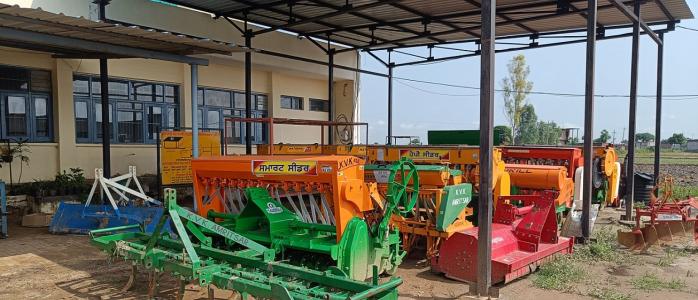
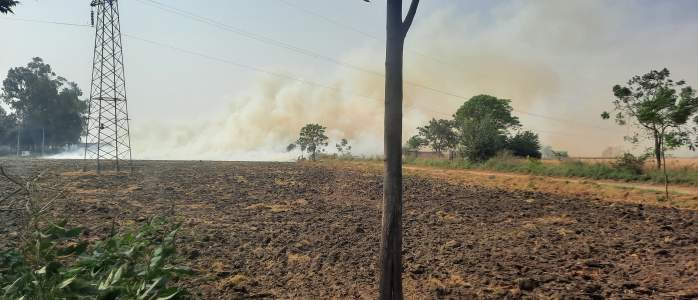
Add new comment